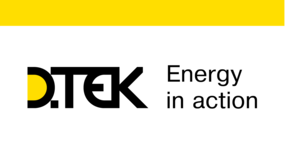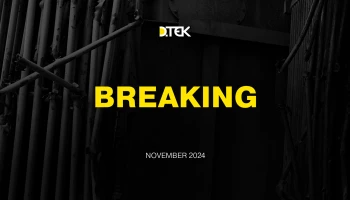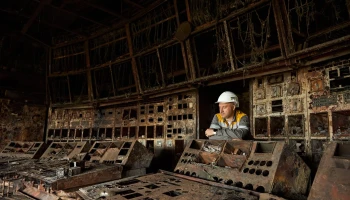In an interview for Liga.Business, Dmytro Sakharuk, DTEK’s Executive Director, spoke about DTEK’s losses from russian shelling, russia’s “filigree” cyberattack, and Ukraine’s future problems this winter.
—Since February, russia has damaged at least 30–40% of the Ukrainian energy sector. How quickly can we restore everything, and what is the safety margin of our energy system?
—The damage is significant. No one expected that their attacks would be so brutal and large-scale. When talking about a massive shelling, we mean a series of missiles launched at the same time at one energy facility, rather than an isolated missile launch. One of our power plants was hit by four missiles at one time.
Some facilities were under several attacks in a row. Their tactics are clear to us: they attack, analyze the consequences, and then attack again. The interval between strikes can be as short as one hour. At least, this is what happened to one of our power plants.
It will be no exaggeration to say that both thermal power plants and substations of Ukrenergo suffered large-scale damage. Some facilities have been destroyed utterly, beyond repair, and need building from scratch. Some can be restored if equipment can be bought and brought. Those with relatively minor damage are repaired, even if partially, and started again.
Our losses are measured in hundreds of millions of dollars.
—Is it only for your group or countrywide?
—This is for our group. We are still dismantling some plant and hope to repair other plant. Ukrenergo, I think, is in the same situation.
As for the time it may take to restore damaged equipment, it is hard to make accurate estimates.
—Do you have many damaged TPPs?
—Five. Some are damaged much more badly than others. A system overhaul and a lot of new equipment will be needed. This is where problems may arise. Take transformers or switches. Their production is project-specific. This is not mass production—you need to order them from the manufacturer and wait until they are ready.
Yes, we can use some used things. Or new things that have not been used yet. In any case, this is expensive equipment that is not so easy to locate.
One switch costs from €110,000, and one transformer costs tens of millions [euro]. And we need more than 20 switches alone. That’s just enough for one or two stations. With each attack, the damage becomes more severe.
—Let’s imagine that you have already ordered this equipment. How long can it take to manufacture, deliver, and install it?
—Deliveries take one to five months. Production takes up to 18 months. But this is not the only problem. Manufacturers have a very long line of electrical equipment orders—two years in advance. So we need to jump the line, buy equipment ahead of other customers.
—Japan and the European Union countries are now helping Ukraine with electrical equipment. How wide is their support?
—We are getting help. And we are deeply grateful to our partners for it. But, overall, equipment we see arriving is for the repair of regional electrical grids. These are low-power transformers and products used for repairing small plant.
Rather, this is aid to the distribution system operators [formerly, oblenergo]. It (supplied equipment.—Ed.) cannot be used to repair Ukrenergo facilities.
However, we are now discussing the consequences. The main problem is shelling.
—russian troops are unlikely to know all Ukrainian energy nodes. Most likely, they are consulted by russian energy specialists. What principle are the russians driven by when picking their targets?
—They aim for critical facilities. Their targets are facilities generating electricity and making the energy system of Ukraine into one whole. The integrity of the power system enables electricity transmission between different parts of the country.
Before the war, we had a fairly powerful electricity grid. But problems began as soon as they started shelling generation and substations. The system simply cannot easily transmit electricity from nuclear power plants to cities in eastern Ukraine.
—So, it was an attempt to break up our energy system into several “islands”?
—Create isolated territories within Ukraine getting electricity from available sources. But if the area has no energy sources, there is no electricity. Of course, there are diesel generators near critical facilities and in hospitals, but this only puts off the disappearance of electricity.
—You might have an explanation. Why did the enemy start their massive attacks on energy in October, even before the heating season started, without waiting for the cold weather?
—In part, it is due to their defeats at the front. They just must respond in a certain way.
Besides, it is terrorism and the intimidation of people. They want to drive Ukrainians out of their comfort zone. They expect to influence our people in this way.
I don’t believe this will work out. Historically, bombing the population and infrastructure of a peaceful city does not produce the desired result without advances at the front. On the contrary, it makes people come together. russians do not get this.
However, they have some “success.” There are power outages throughout the country, creating discomfort for the population. Even if it’s not too cold now.
—Cyberattacks are another way the enemy is using to undermine our energy system. Tell us how you fight off russian cyberattacks and how massive they are?
—The cyber army of the russian Federation is fighting against us. Our facilities are constantly under attack—there have been more than 10 cyberattacks, small and large, over the past three months. We even survived one “super attack” that lasted for a long time and was well planned. I would even call it a filigree attack, but we fought if off due to investments in cyber defense and our experts.
Since 2018, we have specifically had a cybersecurity strategy that we implement and regularly update.
—Were the attacks against a power plant or a substation?
—This time it was not against our office systems, rather than process systems. They are also important as they are for handling our clients, markets, and calculations. If they had succeeded, the scale of the damage would be as large as a cyberattack on a power plant.
—You have said DTEK had five TPPs damaged. Have your employees been injured or killed?
—We have about 60,000 employees. More than 4,500 of them are now serving in the Armed Forces of Ukraine. 97 have been killed as of today. Four people are PoW, 19 missing, 237 injured.
4 and 33 people were killed and injured on the job, respectively. Another 14 and 61 people were injured during off-hours, respectively. This is an enormous toll for us.
—How do you encourage people to come to work in these conditions?
—There is a military front, and there is an energy front. These are no empty words for energy experts. This is their professional duty. For example, our energy experts in Donetsk Oblast have worked under shelling for eight years. They sacrifice their lives and health so that people have electricity.
Last week, the russians shelled one of our power plants. This resulting in a severe accident with ash and slag pipelines broken, creating a risk of flooding the station. The ash and slag pipeline is a large pipe for pumping ash in water. If it stops, the boiler on the power unit cannot run.
So, a few of our workers left the bunker and starting repairing the damage, at which point the shelling resumed. One person was killed. It was a truly heroic act. Such cases are numerous.
We pay our employees “combat allowance,” help the families of killed and injured employees. Of course, no amount of money can replace a father, son, or husband who lost their lives.
—DTEK entered the full-scale war with some experience of how to operate during hostilities. Your stations have been under fire since 2014. What has the war taught you?
—I never believed the war would start, but just in case, we stockpiled fuel, food, equipment, and prepared our team for force majeure.
We started preparing for the full-scale war 20 days before it broke out. We set up a crisis management HQ, prepared bomb shelters at facilities, and began moving important elements of equipment to western Ukraine. We also moved our servers and IT infrastructure first to the west and then abroad. Our head office has moved temporarily.
We made as many preparations as we could because panic hits when the war starts. Everything evaporates in a split second—gas, drugs, food, logistics goes down and contractors disappear.
You only rely on yourself. So, you should be ready for any scenario. Everything that can go wrong will certainly go wrong as soon as hostilities begin. There are no exceptions during a war.
—What scenarios did you prepare for?
—Honestly, we were getting ready back in June this year that Zaporizhzhia NPP would be off the system. We clearly saw that coming.
At that time, it was still running, but we got ready for the worst by heaping up resources, creating reserves.
—What scenarios do you think Ukrainians should be ready for this winter? Disruptions with electricity, heat, natural gas, or a bit of everything?
—Unfortunately, we are still unable to destroy all the missiles and drones targeted at our energy infrastructure. Obviously, new attacks are to come, with new damage to our power system, new problems with electricity.
The worst that can happen is the Alchevsk 2006 scenario, when the entire heat supply system freezes completely. You can still survive without electricity. But, with heating gone, life stops completely.
ABOUT COAL SHORTAGE, LOOTING, ELECTRICITY IMPORTS FROM EUROPE, AND UAH 17.6 BN WORTH OF LOSSES
—Since the full-scale war started, russia has captured about 50% of DTEK’s green generation and 30% of thermal generation. Do you know what is happening at your occupied energy facilities?
—All our wind power plants are in the occupied territory. We know what is happening on them now. They are not running.
—Market players report that the russians are removing equipment from captured power plants. Do you know of such cases?
—Looting does occur. It is difficult to steal a 100-meter windmill, but it is pretty easy to move out solar panels.
We have Tryfonivska SPP, a small solar power plant in Kherson Oblast. It was de-occupied two weeks ago, but it is still in a gray area. 10% of the panels of this SPP have been stolen or destroyed. It needs renovations.
—There is a lot of talk now about the physical status of the Ukrainian energy system, repairs, power outages. But few people talk about its economics. How balanced is the financial position of the market?
—[Nationwide electricity] consumption remains the same at a 30% loss. Besides, the occupation caused a significant decline in the generation by renewable energy sources (solar and wind power plants, etc.) and NPP.
In our country, about 50% of all electricity is produced by nuclear power plants, 25–35% by TPP, and the rest by HPP, CHPP, and renewables combined. The figure changes every day, but the approximate numbers are as follows.
Electricity bill payments have slightly increased to an average of about 90% across the country. But this does not include the front-line and occupied areas.
Very high underpayment exists in Donetsk, Kharkiv, Zaporizhzhia, and Mykolaiv Oblasts (where electricity is supplied by other than DTEK.—Ed.). There are problems in Dnipropetrovsk Oblast. There, people have other things to worry about.
—Last year, TPP accounted for about 25% of the energy mix of the market, now it is up to 35%. Will the country have enough coal in these conditions?
—Consumption [of coal reserves] was high in September and in the first third of October. Now that many stations are damaged, we started consuming less coal.
—Will we need electricity and coal imports this winter?
—Yes, we will. If all or most of our power plants are restored now (some surely won’t) and start working as before the massive shelling, coal will be used up quickly.
Our country faces a shortage of coal. So, we will either import this coal or buy electricity from Europe. It will be difficult to get through this winter without it.
Yes, it will be difficult to import it due to logistical challenges. But Europe does have coal. The only question is its price.
—How will it work? The market is already preparing, but European electricity prices are still much higher than our domestic prices. It turns out that we have to buy expensive there, and sell cheap here. Economy doesn’t work like that.
—Currently, the Price Cap system is not applied (the Price Cap system is a system of limiting electricity prices for business.—Ed.). So, restrictions should be loosened (the maximum price of electricity on the market is 4,000 UAH/MWh today. —Ed.).
In 10 months of 2022, DTEK Energo’s thermal generation produced a loss of UAH 17.6 bn. Everyone on the market is suffering now, but heat generation suffers the most, unfortunately.
—Why?
—In Ukraine, machine-building plants have stopped, iron and steel companies have cut production. To buy equipment for our coal mines, we reach out to foreign markets, which are highly competitive.
First of all, because global coal prices are high at $300 per ton. This is about UAH 12,000 in our currency, while coal is sold for UAH 4,200 per ton in Ukraine.
With coal prices as high as abroad, energy companies are ready to pay a very high price for equipment, which pays back in a matter of months.
Вesides, we get revenue in hryvnias but buy equipment with foreign currency funds.
Today, the cost of coal-fired electricity generation is 4,800–5,000 UAH/MWh. But in the market, electricity now costs up to 3,300 UAH/MWh. In fact, we sell electricity at a loss.
As a result, we are driven to cut investment in coal mining and TPP repairs. This means output will be lower next year.
—To what extent?
—Much lower. To maintain the current rate of coal production, we need to invest and prepare a year ahead by tunneling, bringing equipment etc. All of this takes money, which we now lack.
—Borrowing is another way of getting funds. How do banks currently provide loans for purchases of coal or equipment?
—They do not lend. They don’t want to take risks.
—Can you raise funds in foreign markets?
—No. Just look at our sovereign rating—the markets are closed to us. Our country is ravaged by a war, so aid only comes at the government level. At the corporate level, you are now physically unable to raise funds in foreign markets.
—Should electricity rates for households be revised in these conditions?
—There is a political decision of the government prohibiting rises in electricity rates for households during martial law.
ON PLANNING HORIZON, NATURAL GAS PRODUCTION, MINENERGO’S PROPOSAL, AND THE OIL PROJECT IN WESTERN UKRAINE
—As early as before the war, Maxim Timchenko, DTEK CEO, said that DTEK had a ten-year planning horizon. What is your planning horizon now?
—Fundamentally, nothing has changed. We had and still have plans to develop renewable energy sources. We have no other way but diversify our economy to work without russian coal, natural gas, and oil products. Natural gas is transitional fuel.
We will be talking about developing trading, developing networks. Even coal-fired electricity generation will work for some time—we have no other way out.
Most likely, we will simply be forced to put off our plans for a certain time. Everything depends on how long this war lasts, how much destruction it produces, what happens to the country’s economy, and how we are integrated into the European Union.
There are a lot of variables.
—DTEK suggested even at the onset of the war that the government invest in Lvivvuhillia SOE. But it did not work out. Can you tell me why?
—You got this wrong. We did not show any interest in Lvivvuhillia coal mines. If there were money to be made, investors would flock, but you can’t see any. Why?
There are five mines, with 6,000–8,000 people working, I don’t remember exactly. And they produce 1,500 tons of ordinary coal per day. We have one bench in one mine producing 2,000 tons per day alone. And one mine may include two or three benches.
The Ministry of Energy reached out to us asking what we thought about those mines. We responded to this offer. We analyzed it. I will be frank with you, and let no one take offense at me: you can hardly characterize these enterprises as mines.
Three of the five Lvivvuhillia coal mines have next to no available coal reserves. The remaining two mines need billions of hryvnias of investment so that they become profitable. If you invest in these mines for two years, they can produce more than 2–3 million tons of coal per year.
But such large investments can’t pay back given the current electricity and coal prices in Ukraine.
The cost of production may reach $300 per ton in the first years.
So, investing in these mines is only feasible if coal exports from Ukraine are allowed. But they are not. And we do not understand how long this ban will last. However, even this is not the main thing—our professional opinions regarding the future of Lvivvuhillia coal mines have not been answered yet.
—About transitional fuel. According to preliminary projections, natural gas production in Ukraine may fall by 10% by the end of this year. How will production at your fields be affected?
—I mostly agree with this assessment. We are now trying to extract everything we can in preparation for the winter—not only natural gas, but also coal.
I think our production will drop a little as we had some problems selling condensate at the beginning of the war.
—DTEK owns a deposit in Poltava Oblast, which borders Kharkiv Oblast. When hostilities raged in Slobozhanshchyna, did you stop mining?
—No. We even continued drilling our wells. We partially revised our investment program down, but still drilled four new wells.
—Due to the hostilities, oil and gas companies are now actively looking at deposits in western Ukraine. Are you interested in the west in terms of investing in gas production?
—Yes, we are. We are now considering projects there. I hope that we can implement the oil project, but it is premature to talk about it now. We do want to invest in Ukraine in the future, but should make allowances for the war.






